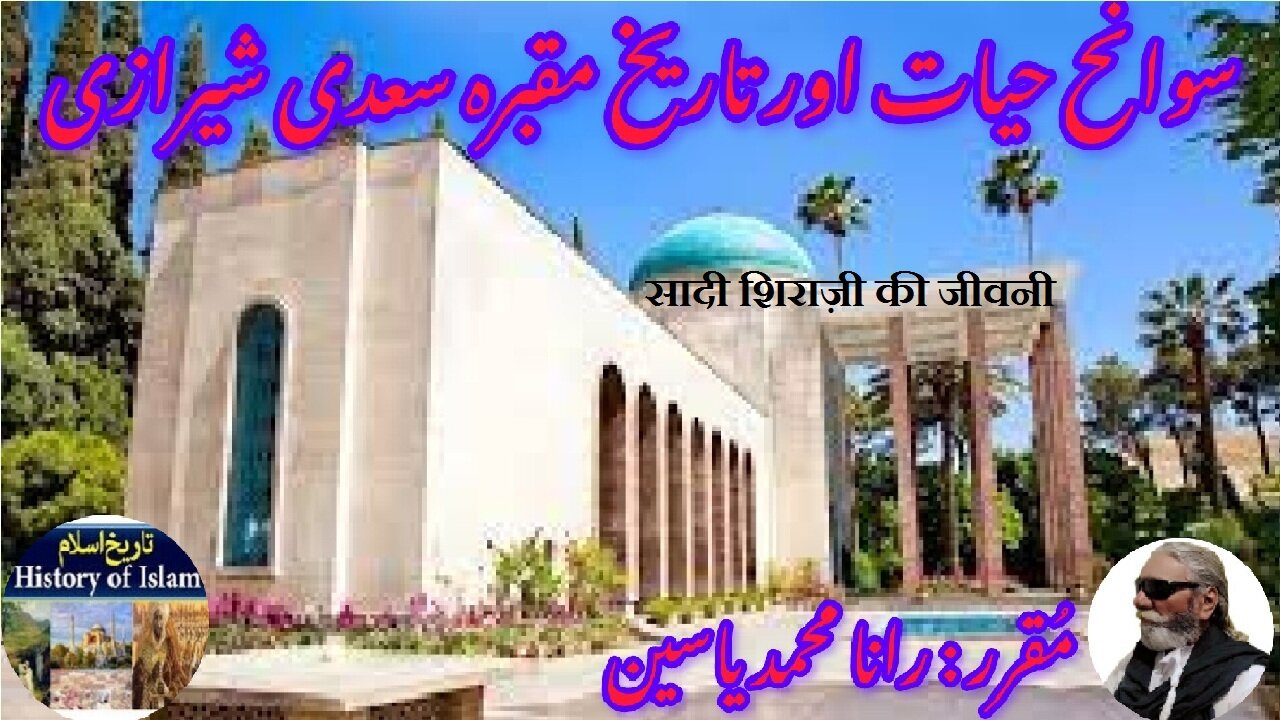Premium Only Content

Biography of Saadi Shirazi | सादी शिराज़ी की जीवनी | سعدی شیرازی کی سوانح اور مزار کی تاریخ
@islamichistory813 #biography #saadi #shirazi #sufisaint #cultural #heritage #biography #islamic #mysticism #islamic #philosophy #shrine #historical #figures
Biography of Saadi Shirazi and the history of his shrine
Dekhti Aankhooon aur sountay kaanoon ko Asslamoalaikum, sisters, brothers friends and elders, in informative series videos of Islamic ascolars, sufisaints, cultural heritages, islamic philosophys, islamic mysticisms and historical figures. today we are describing biography of Saadi Shirazi and the history of his shrine.
Abu Muhammad Musharraf al-Din Musleh ibn Abdullah ibn Musharraf, better known by his pen name Saadi, was a revered Persian poet, prose writer, and scholar, born in 1210 in Shiraz, a city in present-day Iran. Widely considered one of the greatest figures in Persian literature, Saadi's profound social and moral insights, along with his impeccable mastery of language, have earned him a permanent place among the giants of classical literary tradition. His works, particularly *Bostan* (The Orchard) and *Gulistan* (The Rose Garden), have been celebrated not only in Persian-speaking lands but also in Western literature. Saadi’s influence extends across cultures, transcending time and borders, as his works continue to inspire generations of readers worldwide. He is often referred to as “The Master of Speech” due to the beauty, depth, and wisdom of his poetry and prose.
Saadi's early life and education were shaped by his hometown of Shiraz, which was a hub of cultural and intellectual activity during the medieval period. It is believed that he came from a well-educated family, and his early years were marked by a rigorous education in literature, Islamic studies, and philosophy. The intellectual environment of Shiraz played a crucial role in shaping his literary talents. He is thought to have studied at the prestigious Nizamiyya madrasa in Baghdad, where he delved deeper into classical Islamic philosophy, Sufism, and literature. Saadi’s exposure to these various intellectual traditions is reflected in the richness of his writing, which blends Persian poetic forms with profound philosophical and ethical reflections.
Saadi’s life was also marked by travel, which played a pivotal role in shaping his worldview. During his youth, he journeyed extensively, visiting the major intellectual centers of the Islamic world, such as Baghdad, Damascus, and Cairo, and even ventured to India and Central Asia. It is said that Saadi’s travels took him to distant lands, where he witnessed the harsh realities of life, from poverty to social injustice, which would later influence his works. His time spent in the courts of various rulers, as well as his experiences as a prisoner, provided him with firsthand knowledge of the human condition, which he skillfully captured in his writings.
One of the defining moments in Saadi's life was his capture by Crusaders during his travels in Syria. Saadi was imprisoned for several years before being released. This experience of captivity deeply impacted his understanding of human suffering and compassion, and his works reflect an empathy for the poor, the downtrodden, and the oppressed. His ability to empathize with the struggles of ordinary people and his commitment to moral integrity is evident throughout his poetry and prose, which often contain stories and parables that advocate for kindness, justice, and piety.
Saadi’s literary legacy is primarily defined by his two masterpieces, *Bostan* and *Gulistan*. *Bostan*, written in 1257, is a collection of poems that explores themes of ethics, justice, and the importance of moral conduct. The work consists of rhymed couplets and offers valuable life lessons, covering topics such as the virtues of kingship, the importance of self-discipline, and the role of the Sufi mystic in society. *Bostan* is a work that combines both philosophical wisdom and practical guidance, emphasizing the cultivation of virtuous character and the pursuit of spiritual enlightenment. It has remained an essential text in Persian literature and continues to be studied and admired for its insightful moral teachings.
In contrast, *Gulistan*, written in prose in 1258, is a more varied and eclectic work. It is a combination of short stories, anecdotes, and verses, all illustrating the importance of morality, human kindness, and social justice. Saadi uses humor, wit, and storytelling to teach his readers valuable lessons about how to live harmoniously within society. The *Gulistan* is often considered a quintessential work of Persian literature and has been praised for its rich narrative style, which blends poetry and prose seamlessly. Through this work, Saadi advocates for tolerance, wisdom, and the pursuit of inner peace, all the while emphasizing the need for compassion and kindness in everyday life.
Saadi’s poetry is also deeply influenced by Sufism, and his works often explore the mystical relationship between the human soul and the Divine. He believes that true knowledge and wisdom are found through spiritual insight and that the ultimate purpose of life is to attain closeness to God. However, Saadi’s approach to Sufism is deeply practical, and he does not shy away from addressing the ethical and moral responsibilities of individuals within society. His focus on both inner spirituality and external behavior sets him apart as a thinker who valued the integration of mystical wisdom into everyday life.
Saadi died in 1291 or 1292, but his influence has only grown since his passing. His works have been translated into numerous languages and remain highly regarded for their moral and philosophical insights. Saadi’s legacy continues to shape not only Persian literature but also the broader tradition of Islamic thought. His teachings on ethics, social justice, and the importance of human kindness have resonated with generations of readers worldwide.
The shrine of Saadi, located in Shiraz, Iran, is a testament to the enduring legacy of this great poet and philosopher. The Saadi Mausoleum is a place of pilgrimage for those who admire his work and seek to honor his memory. The site is a peaceful and serene location, surrounded by gardens and beautiful architecture, providing visitors with a space to reflect on Saadi's teachings. The mausoleum is decorated with inscriptions of his poetry, and his tomb is often visited by people seeking spiritual solace and wisdom. The surrounding gardens are a symbol of the ideals Saadi championed in his work: beauty, tranquility, and the nurturing of the soul. Visitors to Saadi's shrine come not only to pay their respects but also to connect with the deep moral and spiritual lessons embedded in his poetry. His words continue to resonate today, providing timeless guidance for those who seek wisdom, compassion, and inner peace.
Saadi of Shiraz was a masterful poet and philosopher whose works have had a profound and lasting impact on Persian literature and Islamic thought. His works, especially *Bostan* and *Gulistan*, have remained central to the Persian literary tradition, and his moral teachings continue to inspire readers worldwide. Saadi’s emphasis on ethics, social justice, and the cultivation of spiritual virtues has made him one of the most celebrated figures in the classical literary tradition. His shrine in Shiraz stands as a reminder of his legacy, offering a place for reflection and a connection to the timeless wisdom of one of the greatest poets in history.
With this, we seek your permission until tomorrow, tomorrow we will describe the biography of Farqad al-Sabkhi and the history of his Shrine.
=============================
-
 7:06
7:06
ISLAMIC HISTORY
11 hours agoAbu'l Hasan Ahmad ibn Ibrahim Al-Uqlidisi اسلامی اسکالر ابو الحسن احمد بن ابراہیم العقلدیسی
-
 DVR
DVR
Man in America
11 hours agoGold’s OMINOUS Warning: A Global Monetary Reset That’ll BLINDSIDE Americans
9.78K3 -
 DVR
DVR
Flyover Conservatives
22 hours ago3 Winning Mindsets for Building Life-Changing Habits - Clay Clark; Why Employers Are Ditching DEI - Andrew Crapuchettes | FOC Show
13K -
 LIVE
LIVE
SynthTrax & DJ Cheezus Livestreams
23 hours agoFriday Night Synthwave 80s 90s Electronica and more DJ MIX Livestream POST DISCO / FUNK / R & B Edition
237 watching -
 51:18
51:18
Degenerate Jay
12 hours ago $0.30 earnedJournalist Claims Batman Is A Fascist Like Donald Trump
5.57K6 -
 1:18:27
1:18:27
Glenn Greenwald
8 hours agoGlenn Takes Your Questions on Major Saudi Arabia Celeb Controversies, Zohran Mamdani and the NYC Debate, Anti-ICE Protests, and More | SYSTEM UPDATE #533
104K31 -
 1:13:26
1:13:26
Tundra Tactical
8 hours ago $3.22 earned🛑{LIVE NOW} Gun Nerd Plays Battlefield 6 Great Tundra Nation Get Together Day 4
16.9K1 -
 LIVE
LIVE
GritsGG
8 hours agoRanked Top 70! Most Wins in WORLD! 3734+!
128 watching -
 14:41:39
14:41:39
LFA TV
1 day agoLIVE & BREAKING NEWS! | FRIDAY 10/17/25
206K43 -
 LIVE
LIVE
Joker Effect
2 hours agoRUMBLE COMMUNITY STREAMING NEWS - CA BANS STAKE - ARC RAIDERS - KICK LOYALS TURNING! - NEW X ALGO
449 watching